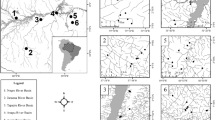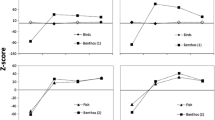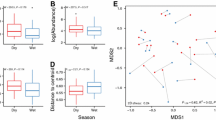Abstract
Beta diversity typically increases with decreasing latitude, with explanations of this pattern often based on tropical origins of most clades. Black flies (Diptera: Simuliidae) are at odds with this trend, having a northern origin. Increasing β-diversity with decreasing latitude might also be a product of changes in causal mechanisms structuring local assemblages among biogeographical realms. We tested the hypotheses that (i) β-diversity of black flies in streams should be similar between the Nearctic and Neotropical realms, and (ii) causal processes influencing species composition do not differ between these areas. To this end, we examined two Nearctic (USA) and two Neotropical data sets (Ecuador, Venezuela). Results did not show distinct differences in β-diversity between Nearctic and Neotropical streams. Although stream conditions varied among regions, we provide evidence that several causal mechanisms of community structure are shared. We suggest that potentially similar causal mechanisms driving species composition contributed to the lack of distinct differences in β-diversity between Nearctic and Neotropical streams. In addition, dispersal appears to influence the β-diversity of larval black flies, a pattern different from many previous studies of stream invertebrates. The influence of taxon origins on β-diversity across biogeographic realms should be further investigated.




Similar content being viewed by others
References
Adler, P. H., D. C. Currie & D. M. Wood, 2004. The Black Flies (Simuliidae) of North America. Cornell University Press, Ithaca.
Adler, P. H., R. A. Cheke & R. J. Post, 2010. Evolution, epidemiology, and population genetics of black flies (Diptera: Simuliidae). Infection, Genetics and Evolution 10: 846–865.
Adler, P. H., J. Barzen, E. Gray, A. Lacy, R. P. Urbanek & S. J. Converse, 2019. The dilemma of pest suppression in the conservation of endangered species. Conservation Biology 33: 788–796.
Allan, J. D. & M. M. Castillo, 2007. Stream Ecology: Structure and Function of Running Waters. Springer, Dordrecht.
Al-Shami, S. A., J. Heino, M. R. Che Salmah, A. Abu Hassan, A. H. Suhaila & M. R. Madrus, 2013. Drivers of beta diversity of macroinvertebrate communities in tropical forest streams. Freshwater Biology 58: 1126–1137.
Altermatt, F., 2013. Diversity in riverine metacommunities: a network perspective. Aquatic Ecology 47: 365–377.
Anderson, M. J., 2001. A new method for non-parametric multivariate analysis of variance. Austral Ecology 26(1): 32–46.
Anderson, M. J., K. E. Ellingsen & B. H. McArdle, 2006. Multivariate dispersion as a measure of beta diversity. Ecology Letters 9: 683–693.
Anderson, M. J., T. O. Crist, J. M. Chase, M. Vellend, B. D. Inouye, A. L. Freestone, N. J. Sanders, H. V. Cornell, L. S. Comita, K. F. Davies, S. P. Harrison, N. J. B. Kraft, J. C. Stegen & N. G. Swenson, 2011. Navigating the multiple meanings of β diversity: a roadmap for the practicing ecologist. Ecology Letters 14: 19–28.
Baselga, A., 2010. Partitioning the turnover and nestedness components of beta diversity. Global Ecology and Biogeography 19: 134–143.
Baselga, A., D. Orme, S. Villeger, J. De Bortoli, F. Leprieur & M. Logez, 2018. betapart: Partitioning Beta Diversity into Turnover and Nestedness Components. R package version 1.5.2. https://CRAN.R-project.org/package=betapart
Brown, B. L. & C. M. Swan, 2010. Dendritic network structure constrains metacommunity properties in riverine ecosystems. Journal of Animal Ecology 79: 571–580.
Brown, B. L., E. R. Sokol, J. Skelton & B. Tornwal, 2017. Making sense of metacommunities: dispelling the mythology of a metacommunity typology. Oecologia 183: 643–652.
Chen, S., Z. Quyang, H. Zheng, Y. Xiao & W. Xu, 2011. Latitudinal gradient in beta diversity of forest communities in America. Acta Ecologica Sinica 31: 1334–1340.
Clarke, K. R. & R. N. Gorley, 2006. PRIMER V6: User Manual/Tutorial. PRIMER-E, Plymouth.
Coccia, C. & J. M. Fariña, 2019. Partitioning the effects of regional, spatial, and local variables on beta diversity of salt marsh arthropods in Chile. Ecology and Evolution 9: 2575–2587.
Coscarón, S. & C. L. Coscarón Arias, 2007. Neotropical Simuliidae (Diptera: Insecta). In Adis, J., J. R. Arias, G. Rueda-Delgado & K. M. Wantzen (eds), Aquatic Biodiversity in Latin America, Vol. 3. Pensoft, Sofia, Bulgaria.
Cottenie, K., 2005. Integrating environmental and spatial processes in ecological community dynamics. Ecology Letters 11: 1175–1182.
Currie, D. C. & P. H. Adler, 2008. Global diversity of black flies (Diptera: Simuliidae) in freshwater. Hydrobiologia 595: 469–475.
De Bie, T., L. De Meester, L. Brendonck, K. Martens, B. Goddeeris, D. Ercken, H. Hampel, L. Denys, L. Vanhecke, K. Van der Gucht, J. Van Wichelen, W. Vyverman & S. A. J. Declerck, 2012. Body size and dispersal mode as key traits determining metacommunity structure of aquatic organisms. Ecology Letters 15: 740–747.
Duarte, A., F. W. Weckerly, M. Schaub & J. S. Hatfield, 2016. Estimating golden-cheeked warbler immigration: implications for the spatial scale of conservation. Animal Conservation 19: 65–74.
Dudgeon, D. (ed.), 2008. Tropical Stream Ecology. Elsevier, Amsterdam.
Fine, P. V. A., 2015. Ecological and evolutionary drivers of geographic variation in species diversity. Annual Review of Ecology, Evolution, and Systematics 46: 369–392.
Freestone, A. L. & R. W. Osman, 2011. Latitudinal variation in local interactions and regional enrichment shape patterns of marine community diversity. Ecology 92: 208–217.
Gaston, K. J. & T. M. Blackburn, 2000. Patterns and Process in Macroecology. Blackwell Science, London.
Göthe, E., A. Baattrup-Pedersen, P. Wiberg-Larsen, D. Graeber, E. A. Kristensen & N. Friberg, 2017. Environmental and spatial controls of taxonomic versus trait composition of stream biota. Freshwater Biology 62: 397–413.
Hamada, N. & P. H. Adler, 1999. Cytotaxonomy of four species in the Simulium perflavum species group (Diptera: Simuliidae) from Brazilian Amazonia. Systematic Entomology 24: 273–288.
Hamada, N., J. W. McCreadie & P. H. Adler, 2002. Species richness and spatial distributions of blackflies (Diptera: Simuliidae) in streams of Central Amazonia, Brazil. Freshwater Biology 47: 31–40.
Hammer, Ø., 2019. PAST: PAleontological STatistics. Version 3.25. Reference Manual. Natural History Museum, University of Oslo, Norway.
Heino, J., 2009. Biodiversity of aquatic insects: spatial gradients and environmental correlates of assemblage-level measures at large scales. Freshwater Reviews 2: 1–29.
Heino, J., 2011. A macroecological perspective of diversity patterns in the freshwater realm. Freshwater Biology 56: 1703–1722.
Heino, J., 2013. Does dispersal ability affect the relative importance of environmental control and spatial structuring of littoral macroinvertebrate communities? Oecologia 171: 971–980.
Heino, J., A. S. Melo, L. M. Bini, F. Altermatt, S. A. Al‐Shami, D. G. Angeler, N. Bonada, C. Brand, M. Callisto, K. Cottenie, O. Dangles, D. Dudgeon, A. Encalada, E. Göthe, M. Grönroos, N. Hamada, D. Jacobsen, V. L. Landeiro, R. Ligeiro, R. T. Martins, M. L. Miserendino, C. S. M. Rawi, M. E. Rodrigues, Fa. de Oliveira Roque, L. Sandin, D. Schmera, L. F. Sgarbi, J. P. Simaika, T. Siqueira, R. M. Thompson & C. R. Townsend, 2015. A comparative analysis reveals weak relationships between ecological factors and beta diversity of stream insect metacommunities at two spatial levels. Ecology and Evolution 5: 1235–1248.
Heino, J. & B. L. Peckarsky, 2014. Integrating behavioral, population and large-scale approaches for understanding stream insect communities. Current Opinion in Insect Science 2: 7–13.
Heino, J. & K. T. Tolonen, 2017. Ecological drivers of multiple facets of beta diversity in a lentic macroinvertebrate metacommunity. Limnology and Oceanography 62: 2431–2444.
Jablonski, K. R. & J. M. Valentine, 2006. Out of the tropics: evolutionary dynamics of the latitudinal diversity gradient. Science 314: 102–106.
Kottek, M., J. Grieser, C. Beck, B. Rudolf & F. Rubel, 2006. World Map of the Köppen-Geiger climate classification updated. Meteorologische Zeitschrift 15: 259–263.
Legendre, P. & M. De Cáceres, 2013. Beta diversity as the variance of community data: dissimilarity coefficients and partitioning. Ecology Letters 16: 951–963.
Legendre, P. & L. Legendre, 2012. Numerical Ecology, Vol. 24. Elsevier, Amsterdam.
Leibold, M. A. & J. M. Chase, 2017. Metacommunity Ecology. Princeton University Press, Princeton.
Leprieur, F., P. A. Tedesco, B. Hugueny, O. Beauchard, H. H. Dürr, S. Brosse & T. Oberdorff, 2011. Partitioning global patterns of freshwater fish beta diversity reveals contrasting signatures of past climate changes. Ecology Letters 14: 325–334.
Maloney, K. O. & P. Munguia, 2011. Distance decay of similarity in temperate aquatic communities: effects of environmental transition zones, distance measure, and life histories. Ecography 34: 287–295.
Maurer, B. A. & B. J. McGill, 2014. Measurements of species diversity. In Magurran, A. E. & B. J. McGill (eds), Biological Diversity: Frontiers in Measurement and Assessment. Oxford University Press, Oxford: 55–65.
McCreadie, J. W. & P. H. Adler, 1998. Scale, time, space, predictability: species distributions of preimaginal black flies (Diptera: Simuliidae). Oecologia 114: 79–92.
McCreadie, J. W. & P. H. Adler, 2012. The roles of abiotic factors, dispersal, and species interactions in structuring stream assemblages of black flies (Diptera: Simuliidae). Aquatic Biosystems. https://doi.org/10.1186/2046-9063-8-14.
McCreadie, J. W. & P. H. Adler, 2018. Patterns of regional beta diversity in a widespread group of North American aquatic insects. Freshwater Science 37: 631–639.
McCreadie, J. W. & P. H. Adler, 2019. Spatial distributions of rare and common species in a widespread group of stream insects. Freshwater Science 38: 53–63.
McCreadie, J. W., N. Hamada & M. E. Grillet, 2004. Spatial–temporal distribution of preimaginal blackflies in Neotropical streams. Hydrobiologia 513: 183–196.
McCreadie, J. W., P. H. Adler & N. Hamada, 2005. Patterns of species richness for blackflies (Diptera: Simuliidae) in the Nearctic and Neotropical regions. Ecological Entomology 30: 201–209.
McCreadie, J. W., N. Hamada, M. E. Grillet & P. H. Adler, 2017. Alpha richness and niche breadth of a widespread group of aquatic insects in Nearctic and Neotropical streams. Freshwater Biology 62: 329–339.
McCulloch, G. A., 2010. Evolutionary genetics of southern stoneflies. PhD dissertation. University of Otago, Dunedin, New Zealand.
Mouquet, N. & M. Loreau, 2003. Community patterns in source-sink metacommunities. American Naturalist 162: 544–557.
Múrria, C., N. Bonada, M. Vellend, C. Zamora-Muñoz, J. Alba-Tercedor, C. E. Sainz-Cantero, J. Garrido, R. Acosta, M. El Alami, J. Barquín, T. Derka, M. Álvarez-Cabria, M. Sáinz-Bariain, A. F. Filipe & A. P. Vogler, 2017. Local environmental rather than past climate determines community composition of mountain stream macroinvertebrates across Europe. Molecular Ecology 26: 6085–6099.
Myers, J. A., J. M. Chase, I. Jiménez, P. M. Jørgensen, A. Araujo-Murakami, N. Paniagua-Zambrana & R. Seidel, 2013. Beta-diversity in temperate and tropical forests reflects dissimilar mechanisms of community assembly. Ecology Letters 16: 151–157.
Nekola, J. C. & P. S. White, 1999. The distance decay of similarity in biogeography. Journal of Biogeography 26: 867–878.
Oksanen, J., F. G. Blanchet, M. Friendly, R. Kindt, P. Legendre, D. McGlinn, P. R. Minchin, R. B. O’Hara, G. L. Simpson, P. Solymos, M. H. H. Stevens, E. Szoecs & H. Wagner, 2019. vegan: Community Ecology Package. R package version 2.5-6. https://CRAN.R-project.org/package=vegan
Qian, H. & J.-S. Song, 2013. Latitudinal gradients of association between beta and gamma diversity of trees in forest communities in the New World. Journal of Plant Ecology 6: 12–18.
Qian, H. & X. Wang, 2015. Global relationships between beta diversity and latitude after accounting for regional diversity. Ecological Informatics 25: 10–13.
Ricklefs, R. E., 1987. Community diversity: relative roles of local and regional processes. Science 235: 167–171.
Rodríguez, P. & H. T. Arita, 2004. Beta diversity and latitude in North American mammals: testing the hypothesis of covariation. Ecography 27: 547–556.
Romdal, T. S., M. B. Araújo & C. Rahbek, 2013. Life on a tropical planet: niche conservatism and the global diversity gradient. Global Ecology and Biogeography 22: 344–350.
Rosenzweig, M. L., 1995. Species Diversity in Space and Time. Cambridge University Press, New York.
Rothfels, K., R. Feraday & A. Kaneps, 1978. A cytological description of sibling species of Simulium venustum and S. verecundum with standard maps for the subgenus Simulium Davies (Diptera). Canadian Journal of Zoology 55: 482–507.
ter Braak, C. & P. Šmilauer, 2012. Canoco Reference Manual and User’s Guide: Software for Ordination (version 5.0). Microcomputer Power, Ithaca.
Thompson, P. L., L. M. Guzman, L. De Meester, Z. Horváth, R. Ptacnik, B. Vanschoenwinkel, D. S. Viana & J. M. Chase, 2020. A process-based metacommunity framework linking local and regional scale community ecology. Ecology Letters 23: 1314–1329.
Viana, D. S., L. Santamaría & J. Figuerola, 2016. Migratory birds as global dispersal vectors. Trends in Ecology and Evolution 31: 763–775.
Whittaker, R. H., 1960. Vegetation of the Siskiyou Mountains, Oregon and California. Ecological Monographs 30: 279–338.
Whittaker, R. H., 1972. Evolution and measurement of species diversity. Taxon 21: 213–251.
Whittaker, R. H., K. J. Willis & R. Field, 2001. Scale and species richness: towards a general hierarchical theory of species diversity. Journal of Biogeography 28: 453–470.
Wiens, J. J. & M. J. Donoghue, 2004. Historical biogeography, ecology, and species richness. Trends in Ecology and Evolution 19: 639–644.
Willig, M. R., D. M. Kaufmann & R. D. Stevens, 2003. Latitudinal gradients of biodiversity: pattern, process, scale and synthesis. Annual Review of Ecology and Systematics 34: 273–309.
Wotton, R. S., B. Malmqvist, T. Muotka & K. Larsson, 1998. Fecal pellets from a dense aggregation of suspension-feeders in a stream: an example of ecosystem engineering. Limnology and Oceanography 43: 719–725.
Ya’cob, Z., H. Takaoka, P. Pramual, V. L. Low & M. Sofian-Azirun, 2016. Distribution pattern of black fly (Diptera: Simuliidae) assemblages along an altitudinal gradient in Peninsular Malaysia. Parasites & Vectors 9: 219.
Acknowledgments
Collecting was made possible by grants from the National Geographic Society (9218-12) to JWM, a National Science Foundation award (DEB-0841636) to PHA, and an INPA/PPI 1-3400 and a CNPq fellowship (201165/93-7) to NH. The research by PHA was supported, in part, by NIFA/USDA under project number SC-1700527; this is Technical Contribution No. 6817 of the Clemson University Experiment Station. Collecting permission was obtained from Parque Nacional Grande Savana, Venezuela (collecting permit from Inparques issued to MEG) and for Esmeraldas province, Ecuador, (collecting permit issued to JWM, Ministerio del Ambient, Esmeraldas Province, MAE-DPAE-2014-0627). An export permit of material from Ecuador was provided by the Ministerio del Ambient, Esmeraldas Province, MAE-DPAE-2014-0511 (issued to JWM). For our Ecuadorian fieldwork, we thank Charlotte Causton (Darwin Foundation) for facilitating our efforts and Denis Mosquera Muñoz for guiding our expedition. We also thank three anonymous reviewers whose detailed comments improved the manuscript.
Author information
Authors and Affiliations
Corresponding author
Additional information
Handling editor: Luis Mauricio Bini
Publisher's Note
Springer Nature remains neutral with regard to jurisdictional claims in published maps and institutional affiliations.
Electronic supplementary material
Below is the link to the electronic supplementary material.
Rights and permissions
About this article
Cite this article
McCreadie, J.W., Hamada, N., Grillet, M.E. et al. A stream by any other name: does β-diversity differ between Nearctic and Neotropical streams?. Hydrobiologia 848, 811–823 (2021). https://doi.org/10.1007/s10750-020-04484-8
Received:
Revised:
Accepted:
Published:
Issue Date:
DOI: https://doi.org/10.1007/s10750-020-04484-8




